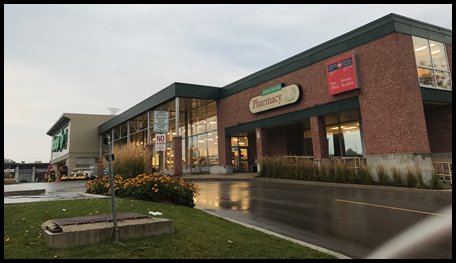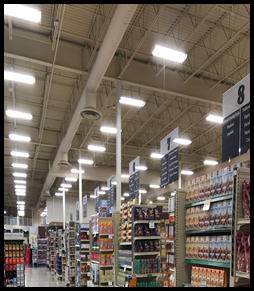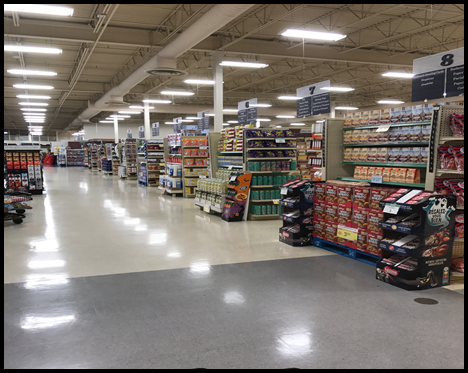Home >> Contributions >> Supermarket as Sitopia
Supermarket as Sitopia
The supermarket revolution has dramatically remodeled the food consumption patterns. Supermarkets account for over 50% of total market share in Canada according to a survey done by Queen's university Investment Counsel (QUIC, 2017). This case study focuses on Sobeys Supermarket as 'sitopia' and analyses it using community capital framework. Sobeys is the second largest food retailer in Canada with approximately 260 stores all over Canada (Empire, 2017).
Physical Capital
 According to Waterloo Corporate Campus Development, the Sobeys supermarket is built on 40-acre site (Empire 2017). Establishment of the supermarket requires large land. Sobeys is capital intensive; it has large storage racks, deep freezers, refrigerators, conveyer belts, cash registers, equipment to store and re-stock the food supplies and more. Further, it has technical infrastructure for maintaining the inventory, the logistical systems, and packaging. It also contains utilities to maintain the actual space such as the floors, shelves and labeling of all the products. Spatiality and physical capital plays an important role in the accessibility of food (Terry, 2004). Due to economies of scale and low prices, more low-income households have access to food. However, research conducted in British Columbia mentions that big supermarket chains such as Sobeys don't open their stores in areas where there are higher crime rates, low-income households and impoverished neighborhoods (supermarket redlining) (Zhang, 2016). This is detrimental towards achieving food security as it is putting vulnerable populations in a more vulnerable position.
According to Waterloo Corporate Campus Development, the Sobeys supermarket is built on 40-acre site (Empire 2017). Establishment of the supermarket requires large land. Sobeys is capital intensive; it has large storage racks, deep freezers, refrigerators, conveyer belts, cash registers, equipment to store and re-stock the food supplies and more. Further, it has technical infrastructure for maintaining the inventory, the logistical systems, and packaging. It also contains utilities to maintain the actual space such as the floors, shelves and labeling of all the products. Spatiality and physical capital plays an important role in the accessibility of food (Terry, 2004). Due to economies of scale and low prices, more low-income households have access to food. However, research conducted in British Columbia mentions that big supermarket chains such as Sobeys don't open their stores in areas where there are higher crime rates, low-income households and impoverished neighborhoods (supermarket redlining) (Zhang, 2016). This is detrimental towards achieving food security as it is putting vulnerable populations in a more vulnerable position.
The locality of Sobeys also plays a crucial role in feeding the Waterloo area. The store is located only 9 minutes drive away from the University of Waterloo campus and further, its only 2 minutes drive away from Waterloo on-campus residential buildings. Additionally, the local bus, Grand River Transport has a bus stop right in front of the store. The fact that Sobeys store is located near a college campus and campus housing and is accessible via public transport, it increases access to food for several sects of communities.
 There is huge amount of electricity and food wastage, which may not be evident through observation but is a conflict in terms of food security and sustainability. AgThentic, an innovation and sustainability consulting firm mentions that 10% of food wasted in Canada derives from supermarkets despite the fact that supermarkets do donate to food banks and have connections with NGOs that distribute the left over food to shelter homes, homeless and low-income households (AgThentic, 2015). Large transportation costs also contribute to green house gases and environmental degradation (Pender, 2015). Further, acquiring and selling of food products contributes to energy wastage. Energy Star reports that an average sized store like Sobeys at waterloo spends more than $200,000 annually on energy costs which results in 1,900 tons of CO2 being emitted into the atmosphere - which is equivalent to emissions from 360 vehicles in a year (Energy Star). Refrigeration and lighting account for over 50 percent of total energy use in the average supermarket, making these systems the best places to start looking for energy efficiency opportunities (Energy Star).
There is huge amount of electricity and food wastage, which may not be evident through observation but is a conflict in terms of food security and sustainability. AgThentic, an innovation and sustainability consulting firm mentions that 10% of food wasted in Canada derives from supermarkets despite the fact that supermarkets do donate to food banks and have connections with NGOs that distribute the left over food to shelter homes, homeless and low-income households (AgThentic, 2015). Large transportation costs also contribute to green house gases and environmental degradation (Pender, 2015). Further, acquiring and selling of food products contributes to energy wastage. Energy Star reports that an average sized store like Sobeys at waterloo spends more than $200,000 annually on energy costs which results in 1,900 tons of CO2 being emitted into the atmosphere - which is equivalent to emissions from 360 vehicles in a year (Energy Star). Refrigeration and lighting account for over 50 percent of total energy use in the average supermarket, making these systems the best places to start looking for energy efficiency opportunities (Energy Star).
Cultural Capital
There is a distinct lack of cultural capital as interactions between the employees and the buyer are reduced to just simple exchanges at the cash register or customer service. There is lack of sense of belonging to a community. Most supermarket buyers do not consciously think about the food sustainability discourse (Kamphuis, 2015). Further, Sobeys is a capitalistic enterprise; the entire supermarket institution is built on affordability and accessibility. Hence, it only attracts consumers that are interested in buying cheaper food from the closest store. Consumers often buy food from supermarket mainly because choices are based on convenience (Kamphuis, 2015). A lot of urban consumers buy pre-prepared meals and food with preservatives in order to minimize cooking time. Moreover, it does not use its scale to influence consumers to make healthier choices (Kamphuis, 2015). Supermarkets like Sobeys have shifted dietary trends towards diets high in saturated fats, sugar and salt (Kamphuis, 2015). That being said, one can argue that ethnically diverse consumers can also somewhat enjoy their experience or built a relationship with the supermarket brand since they can find food from their countries. For instance, Sobeys sells ramen noodles imported from Korea, China and Japan, Indian spices and Sushi. Sobeys store also has Halal food, vegan choices, various dairy options (soy and almond milk), and kosher sausages. Having these food options also helps consumers with specific dietary needs feel a sense of connectedness with the brand and store.
Economic Capital
Sobeys is Empire's only food retailing subsidiary (Empire, 2017). Sobeys has its distinct group of retail stores that are diversified into food, pharmacy, wholesale, liquor and fuel businesses (Empire, 2017). These brands include Sobeys, Safeway, IGA, Foodland, FreshCo, and Thrifty Foods (Empire, 2017). Sobeys being one of the largest food providers has accumulated sales more than $16 billion CAD (Empire, 2017). In terms of supply chain, Sobeys stores get supply from a network of retail support centers (Empire, 2017). Certain products are supplied directly via various vendors (Empire, 2017).
Sobeys does not have diverse forms of market; it is purely built on capitalistic foundations and is committed to having sufficient capital and finances in order to expand the business, investment purposes and maintain minimal risk in order to acquire advantage over competitors (Empire, 2017). Empire Company Ltd. reports that Sobeys has approximately 62,000 full time and part time employees as of 2017.
Monopolization of supermarkets are highly concerning as it crowds out local farmers, traditional food retailers, independent grocery stores and street vendors (Therien, 2017). This is especially concerning because of the increase in imported agricultural goods from international sellers (Therien, 2017). Increase in imports leads to shutting down of local and traditional agricultural producers, which further results in unemployment. Sobeys and Urban consumers are the main stakeholders who benefit from this institution.
Human Capital
Sobeys, being a supermarket, is capital intensive and therefore, has limited human capital investment. Having said that, human capital is required for sales, marketing, physical maintenance of supermarkets, technical support and finance, and customer service (Flora, 2009). Even though there are extremely limited numbers of employees who come in contact with the buyers and facilitate the purchasing especially after self-service check out counters, huge enterprise department takes care of financial management, business development, and retail management (Flora, 2009). Human capital is still required to operate the machines, re-stock the racks and manage all the on-going operations (Flora, 2009).
Natural Capital
 Supermarkets like Sobeys are involved with food production, growth of processing and packaging of items, retailing and distribution of food products that requires copious amounts of water, power, paper and plastic (UNAC). Hence, efficiency is always questioned. According to the United Nations Association in Canada, supermarkets' demand for natural resources is going to grow by 60% over the next 20 years. UNAC also reports that 26% of Sobeys' energy consumption comes from renewable resources however; the company does aim to cut its energy consumptions by 20% by 2020. Sobeys used to use natural refrigeration system such as CO2, hydrochlorofluorocarbon and hydrofluorocarbon systems without realizing that just a kilo of these refrigerant systems is equivalent to a leaking of 4,000 kilograms of carbon dioxide (UNAC). However, Sobeys has taken measurable steps towards implementing more sustainable solutions. Sobeys stores have installed new natural refrigeration systems, which reduce greenhouse gas emissions by 800,000 kilograms per store per year (Nolet, 2017). The new refrigeration systems cut electrical consumption by 15% (Nolet, 2017).
Supermarkets like Sobeys are involved with food production, growth of processing and packaging of items, retailing and distribution of food products that requires copious amounts of water, power, paper and plastic (UNAC). Hence, efficiency is always questioned. According to the United Nations Association in Canada, supermarkets' demand for natural resources is going to grow by 60% over the next 20 years. UNAC also reports that 26% of Sobeys' energy consumption comes from renewable resources however; the company does aim to cut its energy consumptions by 20% by 2020. Sobeys used to use natural refrigeration system such as CO2, hydrochlorofluorocarbon and hydrofluorocarbon systems without realizing that just a kilo of these refrigerant systems is equivalent to a leaking of 4,000 kilograms of carbon dioxide (UNAC). However, Sobeys has taken measurable steps towards implementing more sustainable solutions. Sobeys stores have installed new natural refrigeration systems, which reduce greenhouse gas emissions by 800,000 kilograms per store per year (Nolet, 2017). The new refrigeration systems cut electrical consumption by 15% (Nolet, 2017).
In terms of seafood sustainability, Sobeys work with third-party certification groups that ensure the fish Sobeys sell have been fished in a sustainable way (Notel, 2017). Sobeys is also a member of the Roundtable on Sustainable Palm oil and Beef, which are global non-profits that ensure that country's beef and palm oil industries are extracting resources in an ecological way (Nolet, 2017). Sobeys also sells brands of meat such as Blue Goose poultry, Du Breton pork and Aspen Ridge beef; these brands meet the animal welfare standards of Humane Farm Animal Care, which are a set of standards created by Virginia, based non-profit (Nolet, 2017).
 The efficiency of this capital can become more efficient by reducing electricity wastage, food wastage, connecting more with local farmers and by donating to more food banks. Sobeys should take advantage of skylights, natural daylight sources (Flora, 2009). It can also install sensors to reduce lighting. Supermarkets waste a lot of food due to the expiration date (Flora, 2009). A lot of consumers throw away healthy food based on the expiration date, which is just a guess of optimal freshness (Nolet, 2017). Manufacturers should make more accurate expiration dates so that less food is thrown away (Nolet, 2017). Statistics show that only 850,000 Canadians use food banks every month (Nolet, 2017). Legislation should make it easier for businesses and consumers to donate food; government can offer tax credits to supermarkets that donate food (Nolet, 2017). Sobeys aimed to reduce its food wastage by 30% by 2013 however ended up reducing by 57% in 2013 (Nolet, 2017).
The efficiency of this capital can become more efficient by reducing electricity wastage, food wastage, connecting more with local farmers and by donating to more food banks. Sobeys should take advantage of skylights, natural daylight sources (Flora, 2009). It can also install sensors to reduce lighting. Supermarkets waste a lot of food due to the expiration date (Flora, 2009). A lot of consumers throw away healthy food based on the expiration date, which is just a guess of optimal freshness (Nolet, 2017). Manufacturers should make more accurate expiration dates so that less food is thrown away (Nolet, 2017). Statistics show that only 850,000 Canadians use food banks every month (Nolet, 2017). Legislation should make it easier for businesses and consumers to donate food; government can offer tax credits to supermarkets that donate food (Nolet, 2017). Sobeys aimed to reduce its food wastage by 30% by 2013 however ended up reducing by 57% in 2013 (Nolet, 2017).
Work Cited
"Stop Borrowing from Peter to Pay Paul: The Case for Optimizing Canada's Strategic Niche." UNAC
Empire. ANNUAL INFORMATION FORM . Empire, 2017
Flora, Cornilia. "Making Healthy Choices to Reduce Childhood Obesity: Community Capitals and Food and Fitness." Taylor & Francis, 2009
Gerlsbeck, Rob. "Special Roundtable: Going for the Green." Canadian Grocer, 2015
Kamphuis, Carlijn B. M., et al. "Bourdieu's Cultural Capital in Relation to Food Choices: A Systematic Review of Cultural Capital Indicators and an Empirical Proof of Concept." PLoS ONE, Public Library of Science, 2015
Nolet, Sarah. "5 Things Supermarkets Can (and Should) Do About Food Waste." The Food Rush, The Food Rush , 19 July 2017
Pender, Terry. "Development of Former NCR Site Taking Shape." TheRecord.com, 3 June 2015
QUIC. Canadian Grocery Market Report. QUIC RESEARCH REPORT, 2017
Roe, Terry. Agricultural & Applied Economics Association. Oxford Journals , Aug. 2004
"Simon Fraser UniversityEngaging the World." Community Capital Tool - Centre for Sustainable Development - Simon Fraser University, Center for Sustainable Development Supermarkets: An Overview of Energy Use and Energy Efficiency Opportunities. Energy Star
Therien, Alexandra. The Impact of the Rise of Supermarkets on Household Urban Food Security: A Case Study of Accra, Ghana, University of Guelph, 15 Feb. 2017 Zhang, Mengyao, and Ghosh Debarchana. "Spatial Supermarket Redlining and Neighborhood Vulnerability: A Case Study of Hartford, Connecticut." Transactions in GIS : TG, U.S. National Library of Medicine, Feb. 2016
By
Ms Miha Alam
Economics
Byrn Mawr College
USA.

 |
© 2025 sociologyguide |
 |













